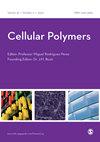用聚合物添加剂稳定液体薄膜
IF 1.9
4区 医学
Q4 MATERIALS SCIENCE, BIOMATERIALS
引用次数: 0
摘要
非挥发性液体薄膜的稳定性是各种应用中的一个关键问题。通常情况下,薄膜会被迫在未被液体润湿的基底上展开。薄膜会在几分钟内破裂并脱水。实现稳定性的常用方法包括引入表面活性低分子量剂或改变基底的化学性质。我们在此介绍一种抑制薄膜破裂的机制,即通过表面附着的聚合物以及薄膜主体中的微量游离聚合物来抑制薄膜破裂。这种效应可能与游离链和表面附着聚合物链的缠结有关,也可能与热力学相互作用的改变有关。本文章由计算机程序翻译,如有差异,请以英文原文为准。
Stabilisation of Thin Liquid Films by Polymer Additives
Stability of thin films of non-volatile liquids is a key issue in a variety of applications. Often a film is forced to spread on a substrate which is not wetted by the liquid. The film then ruptures within minutes and dewets. Common methods for achieving stability include the introduction of surface-active low molecular weight agents, or modification of the chemistry of the substrate. We describe here a mechanism for suppressing the rupture of the films by surface-attached polymers together with trace amounts of free polymers in the bulk of the film. The effect may have a kinetic origin, which is related to the entanglement of free chains and surface-attached polymer chains, or it may be due to a modification of the thermodynamic interactions.
求助全文
通过发布文献求助,成功后即可免费获取论文全文。
去求助
来源期刊

Cellular Polymers
工程技术-材料科学:生物材料
CiteScore
3.10
自引率
0.00%
发文量
9
审稿时长
3 months
期刊介绍:
Cellular Polymers is concerned primarily with the science of foamed materials, the technology and state of the art for processing and fabricating, the engineering techniques and principles of the machines used to produce them economically, and their applications in varied and wide ranging uses where they are making an increasingly valuable contribution.
Potential problems for the industry are also covered, including fire performance of materials, CFC-replacement technology, recycling and environmental legislation. Reviews of technical and commercial advances in the manufacturing and application technologies are also included.
Cellular Polymers covers these and other related topics and also pays particular attention to the ways in which the science and technology of cellular polymers is being developed throughout the world.
 求助内容:
求助内容: 应助结果提醒方式:
应助结果提醒方式:


